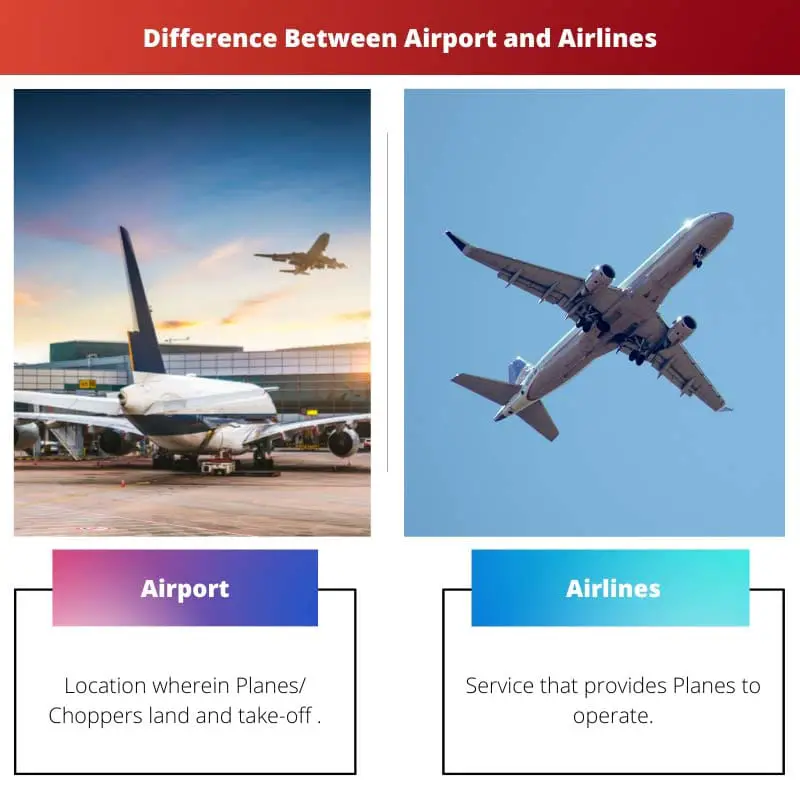Travelling can be a really pleasant experience for a tourist if all the facilities are available and all the terms are clear. Often due to a bad encounter/ experience tourists may blame the Airports instead of the Airlines and vice versa.
Knowing how they operate and stating the subtle differences between them will clarify their respective responsibilities to the passengers traveling through them.
Key Takeaways
- An airport is a facility where airplanes take off and land, while an airline is a company that provides air transportation services.
- Airports are owned and managed by government or private entities, while airlines are privately owned companies.
- Airports provide various passenger services, including security, customs, and baggage handling. In contrast, airlines provide air transportation and may offer additional services such as in-flight entertainment and meals.
Airport vs Airlines
The difference between Airport and Airlines is that Airport is the main ground terminal from where all the planes operate whereas Airlines are companies that offer air transport to passengers. They are responsible for selling tickets, delaying flights, etc. Airlines pay rent to the Airports for letting their flights operate from the area.

An airport consists of runways, taxiways and is also responsible for the immigration procedure, or the boarding protocols. It is a parking system exclusive for the flights to park themselves.
They provide the space for a Plane or Helicopter to take off and land. They also contain spots for passengers to rest and relax before boarding, like restaurants, cafes, shops, etc.
On the other hand, Airlines are companies that provide planes so that the passengers could travel.
An Airline is responsible for all that takes place inside the Airplane, for instance, the food, comfort, facilities, etc., in fact, the prices of the tickets are also decided by the airline.
Airlines decide the Air Network on which they are going to operate, they handle your luggage and are also responsible for the delay in take-off.
Comparison Table
| Parameters of Comparison | Airports | Airlines |
|---|---|---|
| Denotes | Location wherein Planes/ Choppers land and take-off | Service that provides Planes to operate |
| Consists of | Taxiways, Runways, Terminals, etc. | Planes, Flight-crew, etc. |
| Responsible for | Boarding, Immigration, etc. | Price of Tickets, Services inside the plane, Cancellation of Flights, etc. |
| World’s Largest as of now | King Fahd International Airport, Saudi Arabia | American Airlines |
| Environmental Effects | Construction of Airports impact the local weather, destroy the surrounding flora and fauna | Aircraft engines generate noise pollution, Emission of certain gases, etc. |
What is an Airport?
Aforementioned, Airport or Aerodrome is a location specifically dedicated to the takeoff and landing of Planes or Choppers. They are installed with runways, taxiways, helipads, and several other facilities to keep the passengers engaged.
It structurally also possesses an area to store and transport cargo in special planes called cargo flights.
The significance of Airports is well known since the discovery of planes. Earlier, the planes used to land at a specific area and were allotted special areas to land in bad weather conditions.
As soon as new heavy planes were discovered the importance of having a huge area grew immensely which led to the construction of the Airports we witness today.
After the construction of huge runways, the focus shifted to ensure the passengers a comfortable and hassle-free journey. Thus, Airport facilities like cafes, gaming areas, shops were introduced so that the passengers enjoy their free time till boarding.
Airport runways are enabled with LED markings, signs, signals, ATC (Air Traffic Control) service, radio and light navigation, etc., to ensure that every flight lands safely irrespective of any weather.
In case of emergencies, Airports are also set up with emergency services like fire and rescue. Airports must have public transport areas, loading, and unloading areas, passenger seating areas, etc., to ensure maximum passenger comfort.
Owing to these facilities, Airports possess the highest number of workers and have a high rate of employment.
Most of the Airports are constructed specifically in the Metropolitan cities with the highest population to make sure that most of them have access to the easiest and safest form of travel.

What is an Airline?
As mentioned above, Airlines are companies that provide planes and choppers for the passengers to travel. The Airlines are completely responsible for the services or facilities provided inside the airplane.
The case of losing your baggage can also be blamed upon the Airlines and not the Airports.
Airlines need to have an ‘Air Operating Certificate or License’ issued by a government-based Aviation Body.
These Airlines may form a partnership with other Airlines to minimize their costs/ losses, wherein the Aircrafts would fly with a single logo but the services provided will be equally divided between the two or more Airlines.
Airlines can be segregated into those operating only as cargo flights and those operating as full-fledged passenger flights. Cargo Flights are slightly on the lighter side as compared to passenger flights.
They are also categorized as International, Domestic, or Regional Flights depending upon the Air Network they are working in as Airlines possess the sole authority of deciding the Air Network, they wish to work in.
Airlines are responsible for more than 80% of what we experience in a trip, right from deciding the prices of tickets, the duration, and route, schedule of the flights, cancellation, delays, catering services, etc., Airlines are the universal boss.
They pragmatically decide everything right from the beginning of the travel. Every Airline possesses its own set of Captains, First Officers, Cabin Crew, Flight Attendees, etc. They are responsible for any mishap caused by any of the personnel.
The first-ever Airline was the DELAG (A German company) and by the recent data, it is proved that American Airlines is the largest Airline in the world.
Nevertheless, the introduction of many new Airlines has increased the opportunity to travel as there are enough parameters to compare to make the best choice for traveling safe and comfortable.

Main Differences Between Airport and Airlines
- Airports are locations from where the planes complete their takeoff, landing, and park themselves when not in use, whereas Airlines are the companies that provide planes and crew to operate for the passengers to travel.
- Environmental effects caused by construction of Airports are loss of Flora and Fauna, Weather change, etc., whereas Airlines cause effects like emission of Greenhouse Gases, Noise Pollution, etc.
- Airports take care of the passengers by aiding them to reach the planes by providing Airport Buses, Coaches, etc., whereas Airlines ensure that the passengers travel safely and comfortably through their planes by providing facilities inside the plane.
- Airports consist of Air Traffic Control System, Emergency Fire, Rescue Services, Boarding Facilities, Bag Wrap Facilities, etc., whereas Airlines provide their Captains, First Officers, Cabin Crew to operate their flights.
- Airports are equipped with runways, taxiways, parking areas, helipads, etc., whereas Airlines are categorized into Business Class Airlines, Charter Airlines, Legacy Airlines, etc.
- Airports are responsible for the security of the passengers till boarding the plane, whereas Airlines get to decide the price of tickets, schedule including cancellation or postponement of the flights, Airlines also get to decide the Air Network that they are going to operate at.

